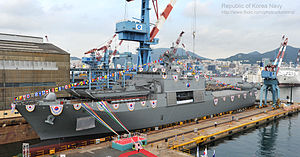Cheon Wang Bong-class tank landing ship
 ROKS Cheon Wang Bong during her launching
| |
| Class overview | |
|---|---|
| Name | Cheon Wang Bong class |
| Builders | Hanjin Heavy Industries, Hyundai Heavy Industries |
| Operators | |
| Preceded by | Go Jun Bong class |
| Built | 2014 - |
| In service | 2014 - present |
| In commission | 2014 - present |
| Planned | 4 |
| Completed | 4 |
| Active | 4 |
| General characteristics | |
| Type | Landing Ship, Tank |
| Tonnage | 4,950 tons (empty) / 7,140 tons (full) |
| Length | 126.9 m (416 ft) |
| Beam | 19.4 m (64 ft) |
| Draught | 5.4 m (18 ft) |
| Installed power | 12,800 hp (9,500 kW) |
| Propulsion | CODAD, 4 × MAN 12V28/33D STC diesel engines rated at 5460 kW, 4 x 6L21/31 auxiliary engines rated 1,200 kW [1] |
| Speed |
|
| Range | 8,000 nmi (15,000 km; 9,200 mi) |
| Boats & landing craft carried | 2 x LCM |
| Troops | 300 |
| Crew | 120 |
| Sensors and processing systems | |
| Armament |
|
| Armor | LIG Nex1 SLQ-200K Sonata electronic warfare suite, Rheinmetall MASS decoy system[2] |
| Aviation facilities | Aft helicopter deck |
The Cheon Wang Bong-class tank landing ship (Korean: 천왕봉급 전차상륙함; Hanja: 天王峰級戰車上陸艦) is an amphibious landing ship class of the Republic of Korea Navy.
Development
[edit]
In the late 1980s the Republic of Korea Navy decided to gradually replace its aging fleet of World War II-era LST-542-class tank landing ships (renamed Un Bong-class LST) purchased from the US Navy in 1958. A three phase plan was laid out to develop new landing ships to meet the demands of modern amphibious and transport operations.
The first phase was designated as the LST-I project, and development and design started in 1987 by Korea Tacoma, currently Hanjin Heavy Industries. After 4 years of development, the lead ship Go Jun Bong (LST-681) was launched in 1991. Three more ships followed and all four ships were commissioned by 1998.
The second phase, or LST-II, was originally planned to import four Newport-class tank landing ships, but after being postponed due to budget issues, it was changed in favor for domestic built 4500-ton LPDs to be commissioned by 2013-2016.[3] After the construction of the first vessel, a follow-on contract for four additional vessels were awarded to Hyundai Heavy Industries in December 2013.[4]
Ships in the class
[edit]| Name | Pennant number | Builder | Launched | Commissioned | Decommissioned | Status |
|---|---|---|---|---|---|---|
| ROKS Cheon Wang Bong | LST-686 | Hanjin Heavy Industries | 11 September 2013 | 1 December 2014 | Active | |
| ROKS Cheon Ja Bong | LST-687 | Hyundai Heavy Industries | 15 December 2015 | 1 August 2017 | Active | |
| ROKS Il Chul Bong | LST-688 | Hyundai Heavy Industries | 25 October 2016 | 2 April 2018 | Active | |
| ROKS No Jeok Bong | LST-689 | Hyundai Heavy Industries | 2 November 2017 | 21 November 2018 | Active |
References
[edit]- ^ "MAN Engines Bound for Korean Navy Vessel - Diesel & Gas Turbine Worldwide - July 2011". Archived from the original on 2016-03-04. Retrieved 2015-01-18.
- ^ "Rheinmetall receives order from South Korea: MASS naval countermeasures system for LST-II-class".
- ^ Chosun Daily - 4천500t급 차기상륙함 윤곽 드러나 10/9/2007 Archived 2007-10-11 at the Wayback Machine
- ^ "S. Korea signs contract to acquire second LST-II landing ship". english.yonhapnews.co.kr.
